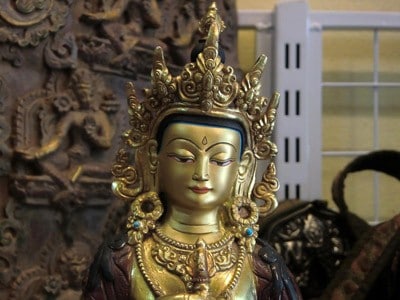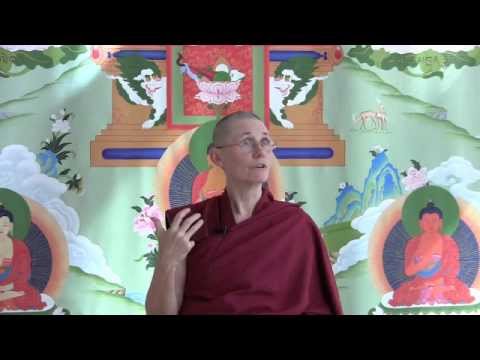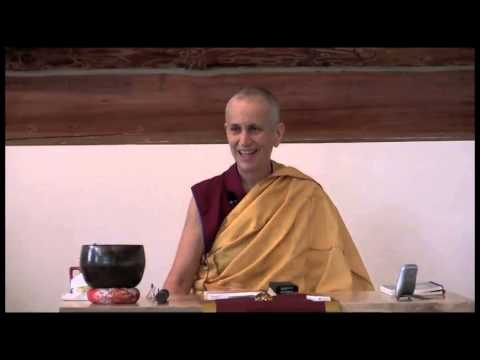Vajrasattva reflections

Ken joined the community at Sravasti Abbey in doing the Vajrasattva retreat the winter of 2011-12. Here he shares some of his reflections on the practice, in the hopes that they will inspire others who are doing the Vajrasattva purification practice.
As a purification practice, the Vajrasattva sadhana affords me the opportunity to undertake a life review. During this process I search out my destructive actions, the intentions that spurred them and the results I may have already experienced or can expect to experience in this or future lives. Engaging the four opponent powers builds up what His Holiness the Dalai Lama refers to as counter-forces to the destructive energies I’ve created. There is no magic; it is simply cause and effect. To avoid the results of a fire, one can deprive it of oxygen or other fuel to remove its causes. In the same way, I can douse the seeds of my destructive karmas by turning my mind to virtue, depriving the seeds of any cooperating conditions.
In the first month of our winter retreat I have come to realize, through both my own practice and sharing in the reflections of others, there are additional advantages to the sadhana. It is no wonder that it is a practice so highly valued. It also indicates the great utility of deity practice from a point of view I hadn’t been able to fully grasp before—wherein the deity is not “out there” but, as a dependent arising of one’s own mind, is united in an effort with the practitioner.
My relationship with Vajrasattva
During this process, it has been helpful to continuously recall that the light and nectar in the visualization represent the enlightened qualities of the Buddhas and my own, future, perfected qualities of compassion and wisdom. These qualities are synonymous with the realizations of the path. The entire path to Buddhahood is brought to bear on my life. The light and nectar are inseparable from the Dharma.
By invoking Vajrasattva, he becomes my guide. When I ask for help and concentrate on the fact that I am applying my own wisdom and compassion I step back from myself. In this process I become an observer to my own life and actions. As a result, I can open the space for transformation by dropping my ordinary self-image, which is usually inflated with pride or full of self-denigration. With Vajrasattva as my guide and this new vantage point I begin to work.
Stepping back and looking around
When the space for transformation opens up in my mind I have to seize the opportunity. In that moment, with my exaggerated self-image weakened, I can view myself in new ways. Reviewing my life, I can recognize myself as a changing and complex entity, weakening the habit I have of identifying with my past, my emotions and my thoughts. This opens the door to self-acceptance, self-compassion and self-love, which are all the roots of love, compassion and equanimity for others.
Complexity
When I simply observe without judgment, with Vajrasattva’s help, I can recognize that often my actions—both destructive and constructive—have been intermixed in ways I didn’t expect. Though at times the afflictions overpower me, within the situation my constructive states of mind sometimes arise creating a tension in my decision. While I might still follow the influence of the afflictions, often the glimmer of my true, caring nature is present. In other cases, I thought I was acting with a sincere motivation but was actually driven by the eight worldly concerns.
This points to the complexity of my actions and the absolute necessity to constantly guard my intentions and motivations. Because my experiences are the results of my past actions, it also points to the complexity of the nexus of causes contributing to my current experiences. I am not all good. I am not all bad. I am simply doing the best I can. Fortunately, “the best I can” can get better through practice.
Paying attention to this complexity and how my intentions have changed over time helps me loosen the stubborn notions I have about myself. I can let go the solid self-image and relax into a stream of events, where I have the ability to direct the flow. This is both relieving and empowering.
Self-acceptance
With full immersion into the light and nectar of my own perfected compassion and wisdom, and that of the Buddhas, I find space for self-acceptance. As I review my state of existence, a natural sense of compassion can arise through the recognition of my suffering states of mind. I can see how the afflictions prevent me from seeing things clearly. It’s a wonderful opportunity to develop a sense of renunciation and recognition of pervasive dukkha, from which emerges compassion.
As I reflect on Vajrasattva’s acceptance of me, out of great love and compassion, eventually a light goes on in the mind. “My goal is to perfect all of my own good qualities and attain Buddhahood in the same way Vajrasattva has done. Therefore, I should emulate Vajrasattva’s enlightened activities as much as I can. I must cultivate acceptance of myself just as Vajrasattva accepts me now.” In fact, the Vajrasattva accepting me in my visualization is my own mind accepting myself at that moment! When I connect with Vajrasattva’s acceptance, I am connecting with my own self-acceptance.
I need not stop at myself, though. I can run through this same thought process with anyone and everyone—extending out to every sentient being. I need only touch Vajrasattva’s mind.
Transformation
Vajrasattva’s qualities of wisdom and compassion, as I visualize and imagine them, are uniting with my own mind stream because through imagination I am also contemplating and, more importantly, experiencing some sense of these qualities. Slowly, I am reinforcing and building up wholesome qualities. Most of this is intellectual recognition on my part but in my limited experience these additional aspects to the practice become deep and meaningful purification.


